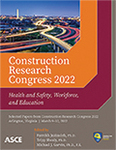A Study on Assessing the Awareness of Heat-Related Illnesses in the Construction Industry
Publication: Construction Research Congress 2022
ABSTRACT
Construction workers often expose to heat stress hazards as temperature and humidity increase. Heat-related illnesses include heat stroke, heat exhaustion, heat cramps, and heat rash conditions. Without immediate and correct treatments, patients may suffer from brain damage or other organ failures, and even death. Heat exposure can also cause fatigue and then lead to other construction accidents. It is crucial to raise awareness of heat-related illnesses and equip people with the means and methods to prevent them from happening. This study aims to assess the current status of people’s knowledge of heat-related illnesses using an online survey questionnaire. The results suggest that further heat-related training should put more focus on the training topics of heat-related illnesses prevention strategies, first-aid, and symptom identifications. The participants whose work is directly related to safety have a better understanding of heat-related illness symptoms than the rest. The results also indicate that the participants’ knowledge of heat-related illness prevention is related to their age and whether they had participated in heat-related training. The findings of this research can help with the development of future heat-related illnesses training and facilitate construction companies to improve their current safety culture and practices.
Get full access to this article
View all available purchase options and get full access to this chapter.
REFERENCES
Acharya, P., Boggess, B., and Zhang, K. (2018). “Assessing Heat Stress and Health among Construction Workers in a Changing Climate: A Review.” International Journal of Environmental Research and Public Health, 15(2), 1–16.
Alshebani, M. N., and Wedawatta, G. (2014). “Making the construction industry resilient to extreme weather: lessons from construction in hot weather conditions.” Procedia Economics and Finance, 18, 635–642.
Arbury, S., Jacklitsch, B., Farquah, O., Hodgson, M., Lamson, G., Martin, H., and Profitt, A. (2014). “Heat illness and death among workers—United States, 2012–2013.” MMWR. Morbidity and mortality weekly report, 63(31), 661.
CDC (Centers for Disease Control and Prevention). (2021). “CDC’s Tracking Network in Action: Extreme Heat.” accessed June 3, 2021. <https://www.cdc.gov/nceh/features/trackingheat/index.html>.
Chan, A. P., and Yi, W. (2016). “Heat stress and its impacts on occupational health and performance.” Indoor and Built Environment, 25. 3–5.
Dutta, P., Rajiva, A., Andhare, D., Azhar, G. S., Tiwari, A., Sheffield, P., and Ahmedabad Heat and Climate Study Group. (2015). “Perceived heat stress and health effects on construction workers.” Indian Journal of Occupational and Environmental Medicine, 19(3), 151.
Farshad, A., Montazer, S., Monazzam, M. R., Eyvazlou, M., and Mirkazemi, R. (2014). “Heat stress level among construction workers.” Iranian Journal of Public Health, 43(4), 492.
Jia, A. Y., Loosemore, M., Gilbert, D., and Rowlinson, S. (2016). “Shielding workers from heat stress: Reconciling the paradoxes of protection and production logics.” In Proceedings of the 32nd Annual ARCOM Conference (Vol. 1, pp. 607–616). Association of Researchers in Construction Management Manchester, UK.
Lucas, R. A., Epstein, Y., and Kjellstrom, T. (2014). “Excessive occupational heat exposure: a significant ergonomic challenge and health risk for current and future workers.” Extreme Physiology & Medicine, 3(1), 1–8.
OSHA. (2021). Heat Illness Prevention Campaign. Accessed June 3, 2021. <https://www.osha.gov/heat>.
OSHA Susan Harwood Training Grant. (2021). Accessed June 3, 2021. <https://www.osha.gov/harwoodgrants/grantmaterials/fy2011/sh-22302-11>.
Park, J., Kim, Y., and Oh, I. (2017). “Factors affecting heat-related diseases in outdoor workers exposed to extreme heat.” Annals of occupational and environmental medicine, 29(1), 1–6.
Rameezdeen, R., and Elmualim, A. (2017). “The Impact of Heat Waves on Occurrence and Severity of Construction Accidents.” International Journal of Environmental Research and Public Health, 14(1), 1–13.
Rowlinson, S., YunyanJia, A., Li, B., and ChuanjingJu, C. (2014). “Management of climatic heat stress risk in construction: A review of practices, methodologies, and future research.” Accident Analysis & Prevention, 66, 187–198.
Song, S., Awolusi, I., and Marks, E. (2017). “Impact of discretionary safety funding on construction safety.” Journal of Safety Health and Environmental Research, 13(2), 378–384.
Song, S., Lyu, Q., Marks, E., and Hainen, A. (2018). “Steel manufacturing incident analysis and prediction.” Journal of Safety, Health and Environmental Research, 14(1), 331–336.
Takakura, J. Y., Fujimori, S., Takahashi, K., Hijioka, Y., Hasegawa, T., Honda, Y., and Masui, T. (2017). “Cost of preventing workplace heat-related illness through worker breaks and the benefit of climate-change mitigation.” Environmental Research Letters, 12(6), 064010.
Tymvios, N., Behm, M., Jia, A. Y., and Johnson, K. (2016). “Heat Stress in the U.S. Construction Industry.” Heat Stress in the U.S. Construction Industry, 1–10.
Xiang, J., Bi, P., Pisaniello, D., and Hansen, A. (2014). “Health impacts of workplace heat exposure: an epidemiological review.” Industrial health, 52(2), 91–101.
Xiang, J., Hansen, A., Pisaniello, D., and Bi, P. (2016). “Workers’ perceptions of climate change-related extreme heat exposure in South Australia: A cross-sectional survey.” BMC Public Health, 16(1), 1–12.
Yamazaki, F. (2013). “Effectiveness of exercise-heat acclimation for preventing heat illness in the workplace.” Journal of UOEH, 35(3), 183–192.
Yi, W., and Chan, A. (2017). “Effects of Heat Stress on Construction Labor Productivity in Hong Kong: A Case Study of Rebar Workers.” International Journal of Environmental Research and Public Health, 14(9), 1055.
Information & Authors
Information
Published In
History
Published online: Mar 7, 2022
Authors
Metrics & Citations
Metrics
Citations
Download citation
If you have the appropriate software installed, you can download article citation data to the citation manager of your choice. Simply select your manager software from the list below and click Download.
Cited by
- Sepehr Khorshid, Siyuan Song, Kaiwen Chen, Peiyi Lyu, A Review of Non-Invasive Heat Stress Monitoring Systems for Construction Workers Using Wearable Device and Computer Vision Technology, Computing in Civil Engineering 2023, 10.1061/9780784485248.073, (606-613), (2024).
